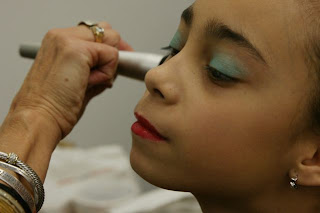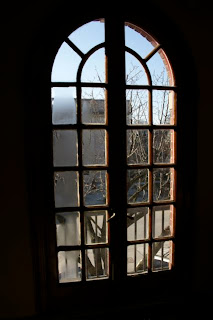I've worked with my artist husband on two previous books—
Ghosts in the Garden (New World Library) and
Zenobia: The Curious Book of Business (Berrett-Koehler). This past year, we've been collaborating on a third—
Dr. Radway's Sarsaparilla Resolvent, an illustrated teen novel that features Philadelphia's own Baldwin Locomotive Works, Eastern State Penitentiary, the great Schuylkill River, a blowzy named Pearl, and my hero George Childs, among other places and souls. It features, as well, the odd tonics and medicines of the time—the strange promises and possible powers of herbal concoctions and flowering vines. William of
Dangerous Neighbors fame stands at the center of this novel. Two twins waft through.
This morning, my husband has completed the design of the book's cover (he has also created nearly a dozen interior illustrations), and while I cannot unveil the whole, I am happy to share this small corner of an image that perfectly captures 1871 and, at the same time, suggests the story's very modern spirit.
I am ridiculously happy about all of this. Not just that the book will exist (spring 2013). But that my fictional William was rendered by my real-life William, and that a very kind press is giving both a home.
Yesterday, before class, I sought a place to pray for all the heartbreak that is Japan. I walked to a garden beyond the veil of steam that gushes through the old medical school grates. I walked the alley between the new vet buildings. I keep walking west and south up to 42nd Street, until I found myself here, at Woodlands. Once the home (purchased in 1735) of Andrew Hamilton, the estate was ultimately willed to Hamilton's grandson William, a botanist and architectural enthusiast who built his grand mansion on the far edge of the grounds overlooking the Schuylkill River.
In time, part of the Woodlands estate became home to the University of Pennsylvania. Part became a cemetery, and today that cemetery, with its original home and stables, sits on the National Historic Landmark list. Thomas Eakins, the painter, is buried there. So is Silas Weir Mitchell, the physician-writer, and William Rush, the sculptor, and Rembrandt Peale, the artist, and Jessie Willcox Smith, the illustrator, and Paul Philippe Cret and Wilson Eyre, both architects. The man who founded Campbell Soup is here. So is Anthony Drexel, who, among other things, funded Drexel University and helped create America's first true suburban community, Wayne. And once the body of George W. Childs, a quiet hero in two of my books, lay in the Drexel family vault at Woodland, his goodness permeating.
But I was the sole living soul on this gray day. I went deep, to the edge, to the western reach of the river. By the time I returned to campus my students were gathering for what would be a most intense, most extraordinary conversation. My job, I keep reminding them, reminding me, is to push them each as far as they can go. Because sometimes love looks like
do not change a word. And sometimes it looks like,
frame it newly, reimagine the tone. Hope is there, inside both conversations. Faith that these young writers are going far.
 I had a week that plunged me into so many different places in my head that I wake this morning feeling fractured. There I was, walking around with Katherine, my fictional character of Philadelphia 1876. There I was back on the cortijo in southern Spain, recalling with my old cook, Stella, the reverberating horrors of the Spanish Civil War. I was editing a piece for a client on a dialysis center. I was looking forward at health care trends. I was talking with Barbara DeMarco-Barrett about the making of memoir and fiction.
I had a week that plunged me into so many different places in my head that I wake this morning feeling fractured. There I was, walking around with Katherine, my fictional character of Philadelphia 1876. There I was back on the cortijo in southern Spain, recalling with my old cook, Stella, the reverberating horrors of the Spanish Civil War. I was editing a piece for a client on a dialysis center. I was looking forward at health care trends. I was talking with Barbara DeMarco-Barrett about the making of memoir and fiction.
And then, yesterday, there I was at the Constitution Center, waiting my turn for that seat before the big green screen and the phenomenally well-informed Mark Moskowitz, rehearsing in my head all that I think I know about George Childs, the great Philadelphia newspaper editor, philanthropist, and community builder. I'd been asked to share my thoughts on behalf of a PBS American Experience documentary-in-progress on the life of my city. I was wondering, as I waited, what I really had to contribute. I was feeling less than.
This, then, is what happened: I met Stephanie, in make-up, who redesigned my face and chatted all the while about dance choreographers (one of my favorite topics). I met Damon Sinclair, who promised to show me his box step. The lighting guys were kind, and Mark's questions were fantastic, and all of a sudden I forgot to feel the panic I'd arrived with. I walked into a community—I, the lonesome writer—and was given a place. George Childs came alive again, thanks to the caring of many.
 This coming Thursday, I'll be down at the Constitution Center being interviewed for the still-to-be-titled Sam Katz documentary on Philadelphia. I'll be talking about one of my favorite Philadelphians of all time, the philanthropist and Public Ledger editor, George Childs, and about a period of time (the late 19th century) that has forever captured my own imagination.
This coming Thursday, I'll be down at the Constitution Center being interviewed for the still-to-be-titled Sam Katz documentary on Philadelphia. I'll be talking about one of my favorite Philadelphians of all time, the philanthropist and Public Ledger editor, George Childs, and about a period of time (the late 19th century) that has forever captured my own imagination.
Yesterday, while speaking with one of the film's producers—while trying again to conjure Philadelphia at what I feel was its most glorious—my thoughts sifted back toward this passage from my novel-in-progress:
Katherine climbs and tells no one where she is. She climbs looking for her end, her final day. She’s climbed through February and March, through April and May, through seasons that cannot decide on the weather, confusing the tulips and squirrels and Katherine as well, who nevertheless finds her way. Sometimes Katherine leaves the house in a light wool dress with a scarf looped loose around her neck and then, of a sudden, the weather will change. In will blow an infiltrating wind and there Katherine will be on Belmont Hill, all the way up, on the highest tier of the Sawyer Observatory. She’ll secure the scarf around her chin and stay. She’ll stand until the city can be seized—the coves and hollows of the Centennial park; the spire of Saint Peter and Paul; the houses, theaters, marketplaces, banks set tight upon the city’s checkerboard squares; the bulbous steam above Baldwin Locomotives. She’ll stare out onto the Renaissance pile of City Hall—like a cake, she thinks, with excess butter cream. She’ll look for a clap of bakery flour. And it won’t matter how fiercely the weather blows: Katherine stands. She stands and dares herself to the very edge, almost but not quite losing her balance. Getting ready.
“Anna,” Katherine says aloud, “how could you?”







yay!!! This is exciting, indeed. :)
How exciting!